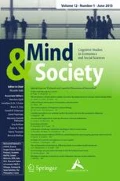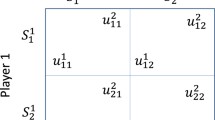Abstract
The question posed is whether the optimization methods of calculus that are often used in social and scientific analyses offer an appropriate analytical approach to analyze problems that are immersed in systemic complexity and its consequences. This paper refers to the portfolio of such complex problems belonging to social and scientific forces. We refer to such a complex combination by the term ‘socio-scientific’. In the study of socio-scientific complexity, dynamic preferences, intricate decisions, and uncertain behavior, endogenous relations and systemic perturbations abound. The arguments presented in this paper establish that the methodological approach of optimization and steady-state equilibrium turns out to be nicety rather than objectivity in the presence of complexity. Complex situations of the socio-scientific universe cause perturbations in the variables; there explaining complexity formed by the social embedding of variables. Indeed, human individuals, institutions and governments, and society at large are complex interrelated entities. Therefore, complex interrelations caused by social embedding remain submerged in social perturbations. However, interactions arising from social embedding (the cause of interrelations between variables) also generate endogenous and complex relations. The contribution of this paper is in the area of endogenous learning in the wellbeing objective criterion function. The interrelationships between the emergent cognitive variables now cause interactive embedding, complexity, and social perturbations. Yet such perturbations are not altogether uncontrollable. They can be and need to be controlled for the purposes of social explanation—hence demanding predictability—even as the complex nature of evolutionary systemic learning proceeds. The controllability problem of extreme perturbations leads us to formalize a mathematical methodology to study controllable perturbations while avoiding extreme forms of perturbations in socio-scientific theory.
Similar content being viewed by others
Notes
Ledger C. & Pickard S. (eds.) 2004 Creation and Complexity: Interdisciplinary Issues in Science and Religion. ATF Press, Adelaide, Australia write in their Introduction (p.xi-xxiv; xv): “Gunton argues that God is a being-in-relation and that a dynamic or relatedness marks God’s creative activity in the world. The network of relations between God and humankind, among humankind and between humankind and the rest of the universe find their basis in the relational nature of God’s creative being. The world’s unity and diversity are born of God. The complexity of the world and its interrelations, according to a Trinitarian understanding of creation, is natural and is manifested in the relations between the smaller physical particles as well as in ecosystems and human social structures.”
Kant I (Critique of Judgment, trans. Pluhar 1987; quoted in Ledger & Pickard op cit, p. 8): “Parts bind themselves mutually into the unity of a whole in such a way that they are mutually cause and effect of one another”.
References
Bertuglia CS, Vaio F (2005) Dynamical systems and the phase space. In: Bertuglia CS, Vaio Nonlinearity F (eds) Chaos and complexity, the dynamics of natural and social systems. Oxford University Press, Oxford, pp 49–70
Burstein M (1991) History versus equilibrium: Joan Robinson and time in economics. In: Rima IH (ed) The joan robinson legacy. M.E. Sharpe, New York, pp 49–61
Choudhury MA (2010) Unity of knowledge versus Kant’s heteronomy with a reference to the problem of money, finance and real economy relations in a new global financial architecture. Int J Soc Econ 37(10):764–768
Edel A (1970) Science and the structure of ethics. In: Neurath O, Carnap R, Morris C (eds) Foundations of the unity of science. University of Chicago Press, Chicago, pp 277–377
Fitzpatrick T (2003) Postmodernism and new directions. In: Alcock P, Erskine A, May M (eds) Social Policy. Blackwell, Oxford, pp 125–133
Foucault M (1983) The archeology of the human sciences. University of Chicago Press, Chicago IL, pp 44–78
Friedman A (1982) Foundations of modern analysis. Dover Publications, New York
Grandmont JM (1989) Temporary equilibrium. In: Eatwell J, Milgate M, Newman P (eds) New palgrave: general equilibrium. W.W. Norton, New York, pp 297–304
Gruber TR (1993) A translation approach to portable ontologies. Knowl Acquis 5(2):199–200
Gunton C (1993) The one, the three and the many: god, creation and culture of modernity. Cambridge University Press, Cambridge
Halmos PR (1974) Measure theory. Springer-Verlag, New York
Hammond M, Howarth J, Keat R (1991) The project of phenomenology. In: Hammond M, Howarth J, Keat R (eds) Understanding phenomenology. Basil and Blackwell, Oxford, pp 14–43
Kant I, Pluhar WS (1987) The critique of judgment. Hackett Publishing Co, Inc., Indianapolis, IN, USA
Krugman P (1996) The self-organizing economy. Blackwell Publishers, Cambridge
Ledger C, Pickard S (eds) (2004) Creation and complexity: interdisciplinary issues in science and religion. ATF Press, Australia
Maxwell G (1962) The ontological status of theoretical entities. In: Feigl H, Maxwell G (eds) Minnesota studies in the philosophy of science, vol II., Scientific ExplanationSpace and Time. University of Minnesota Press, Minneapolis, pp 3–27
McCulloch WS (1970) Embodiments of mind. MIT Press, Massachusetts
Myrdal G (1958) The principle of cumulation. In: Streeten P (ed) Value in social theory, a selection of essays on methodology by gunnar myrdal. Harper & Brothers Publishers, New York, pp 198–205
Nikaido H (1968) Convex structure and economic theory. Academic Press, New York
Sklair L (2002) Transnational corporations and capitalist globalization. In: Sklair J Globalization, capitalism and its alternatives. Oxford, Eng: Oxford University Press, pp. 59–83
Soros G (1998) The Crisis of Global Capitalism. Public Affairs, New York, Chapters 1–4
Taleb NN (2007) The black swan: the impact of the highly improbable. Random House, New York
Taleb NN (2008) The fourth quadrant: a map of the limits of statistics. In: Edge, The Third Culture (online). http://www.edge.org/3rd_culture/taleb08/taleb08_index.html
Wallerstein I (1998) Spacetime as the basis of knowledge. In: Bordo OF (ed) People’s participation, challenges ahead. Apex Press, New York, pp 43–62
Author information
Authors and Affiliations
Corresponding author
Appendix: interactive, integrative, evolutionary learning model
Appendix: interactive, integrative, evolutionary learning model

Rights and permissions
About this article
Cite this article
Choudhury, M.A., Ahmed, M.S. Perturbation theory in cognitive socio-scientific research: towards sociological economic analysis. Mind Soc 12, 203–217 (2013). https://doi.org/10.1007/s11299-013-0115-7
Received:
Accepted:
Published:
Issue Date:
DOI: https://doi.org/10.1007/s11299-013-0115-7



